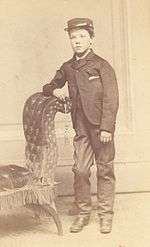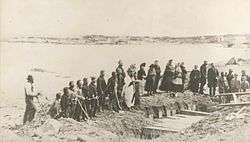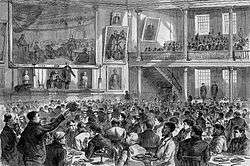SS Atlantic
RMS Atlantic was a transatlantic ocean liner of the White Star Line that operated between Liverpool, United Kingdom, and New York City, United States. During the ship's 19th voyage, on 1 April 1873, she struck rocks and sank off the coast of Nova Scotia, Canada, killing at least 535 people. It remained the deadliest civilian maritime disaster in the North Atlantic Ocean until the sinking of SS La Bourgogne on 2 July 1898 and the greatest disaster for the White Star Line prior to the loss of Titanic in April 1912.
 RMS Atlantic | |
| History | |
|---|---|
| Name: | Atlantic |
| Namesake: | Atlantic ocean |
| Owner: | White Star Line |
| Operator: |
 |
| Port of registry: |
|
| Builder: |
|
| Yard number: | 74 |
| Laid down: | 1870 |
| Launched: | 26 November 1870 |
| Completed: | 3 June 1871 |
| Maiden voyage: | 8 June 1871 |
| In service: | 8 June 1871 |
| Out of service: | April 1st 1873 |
| Fate: | Ran onto rocks and sank off the coast of Lower Prospect, Nova Scotia, 1 April 1873 |
| Status: | Scrapped at wreck site |
| Notes: | The second ship built for the White Star line after being acquired by Thomas Ismay |
| General characteristics | |
| Class and type: | Oceanic-class ocean liner |
| Type: | Ocean liner |
| Tonnage: | 3,707 tons |
| Length: | 128.4 m (421.3 ft) |
| Beam: | 12.4 m (40.7 ft) |
| Draught: | 11 ft (3.4 m) |
| Decks: | 4 |
| Installed power: | Steam engine producing 600 hp (450 kW) |
| Propulsion: | Single propeller, sail |
| Sail plan: | Four masts |
| Speed: | 14.5 knots (26.9 km/h) |
| Boats & landing craft carried: | 10 lifeboats |
| Complement: | 1,166 passengers |
History
Atlantic was built by Harland and Wolff in Belfast in 1870, and was the second ship built for the newly born White Star Line. She was powered by a steam engine producing 600 horsepower (450 kW) driving a single propeller, along with four masts rigged for sail. She sailed for New York City on her maiden voyage on 8 June 1871.
Disaster


On 20 March 1873 Atlantic departed on her 19th voyage from Liverpool with 952 people on board, of whom 835 were passengers, 2 of whom were babies born during the voyage, and 14 stowaways. En route, because of heavy seas and strong headwinds slowing their progress, Captain Williams became concerned that they would run out of coal for the boilers before reaching New York. They in fact had more than enough remaining fuel, but the ship's engineer had been purposefully under-reporting coal reserves to increase the margin for error in favor of safety. Thus convinced they were short of coal—and unable to hoist sail as a backup because of the strong headwind—the captain decided to divert to Halifax, Nova Scotia, to refuel.
During the approach to Halifax on the evening of 31 March, the captain and third officer were on the bridge until midnight while Atlantic made her way through a storm, proceeding at 12 knots (22 km/h) for the entrance of Halifax harbour, experiencing intermittent visibility and heavy seas. Unbeknownst to the crew or passengers, winds and currents had put Atlantic approximately 12 1⁄2 miles (20.1 km) off-course to the west of Halifax Harbour. Because almost none of the crew had ever been to Halifax before, they were unaware of the dangers of the approach; no one took soundings, posted a masthead lookout, reduced speed, or woke the captain as they approached the unfamiliar coast. They did not spot the Sambro Lighthouse, the large landfall lighthouse which warns mariners of the rocky shoals to the west of the harbour entrance. As the night wore on without any sight of the lighthouse, the helmsman—the only crew member familiar with Halifax—became convinced that something was wrong, and relayed his concerns to the officers on duty, but was ultimately ignored.
At 3:15 a.m. local time on 1 April 1873, Atlantic struck an underwater rock off Marr's Head, Meagher's Island (now Mars Head, Mars Island), Nova Scotia.[1][2][3] All 10 lifeboats were lowered by the crew but were all washed away or smashed as the ship quickly filled with water and partially capsized. Survivors were forced to swim or climb ropes first to a wave-swept rock and then to a barren shore. Residents of the tiny fishing village of Lower Prospect and Terence Bay soon arrived to rescue and shelter the survivors, but at least 535 people died, leaving only 371 survivors.[4] The ship's manifest indicates that of the 952 aboard, 156 were women and 189 were children (including two who had been born during the voyage). All women and all children perished except for one twelve-year-old boy, John Hindley. Ten crew members were lost, while 131 survived.[5] This was the worst civilian loss of life in the North Atlantic until the wreck of La Bourgogne on 2 July 1898. The Canadian government inquiry concluded with the statement, "the conduct of Captain Williams in the management of his ship during the twelve or fourteen hours preceding the disaster, was so gravely at variance with what ought to have been the conduct of a man placed in his responsible position."
Recovery of the dead
.jpg)
%2C_Lower_Prospect%2C_Halifax_County%2C_Nova_Scotia%2C_Canada%2C_April_1873.jpg)

Recovery and burial of the large numbers of victims took weeks. Divers were paid rewards for recovering the many bodies trapped within the hull. According to one newspaper account, a body of one of the crew members was discovered to be that of a woman disguised as a man. "She was about twenty or twenty-five years old and had served as a common sailor for three voyages, and her sex was never known until the body was washed ashore and prepared for burial. She is described as having been a great favorite with all her shipmates, and one of the crew, speaking of her, remarked: 'I didn't know Bill was a woman. He used to take his grog as regular as any of us, and was always begging or stealing tobacco. He was a good fellow, though, and I am sorry he was a woman."[6]
Legacy

SS Atlantic was the second liner commissioned by White Star (Oceanic being first) but carried the notoriety of being the first White Star Line steamer to sink. (The company had previously lost the clipper Tayleur in Dublin Bay in 1854.) Other White Star Line ships lost in the North Atlantic include Naronic in 1893, Republic in 1909, and Titanic in 1912.
Today, most of the ship lies heavily fragmented under 40 to 60 feet (12 to 18 m) of water.[7] Artifacts recovered from several salvage operations are on display at the Maritime Museum of the Atlantic in Halifax, Nova Scotia and also at the SS Atlantic Heritage Park and Interpretation Centre, in Terence Bay, Nova Scotia. A monument to the wreck is located at the mass grave near the interpretation centre in the Terence Bay Anglican Cemetery, while a smaller monument marks a second mass grave at the Catholic cemetery.
When the 1929 film Atlantic was released, everyone knew it was a thinly disguised story about the sinking of the Titanic in 1912. Though this film was based on a stage play it also was made only seventeen years after the actual Titanic sinking and the public, especially survivors and their families, felt uncomfortable with a direct reference to Titanic. The producers of the film decided to release the movie under the title Atlantic, apparently unaware of the previous White Star Line disaster.
P.G. Wodehouse wrote a story in 1921 called "The Girl On The Boat" in which six chapters of the romance take place on a White Star liner he named "Atlantic", crossing from New York to Southampton. As the real "Atlantic" disaster had occurred 48 years before the story and 8 years before he was born, it is unlikely that he knew about it.
References and sources
- Author Unknown "Mars Island History", Retrieved on 21 March 2013.
- Author Unknown "Mars Island Map", Retrieved on 21 March 2013.
- Clancy, Dave "Shipwrecks of Nova Scotia", Retrieved on 21 March 2013.
- Greg Cochkanoff and Bob Chaulk, SS Atlantic: The White Star Line's First Disaster at Sea, (Goose Lane Editions, Fredericton, 2009) p. 163. Estimates range from 535 to 560 lives lost. The official Inquiry in Halifax concluded that 535 people had perished. Exact numbers were difficult to determine due to changes in the passenger list and misspelling of names.
- Greg Cochkanoff and Bob Chaulk, SS Atlantic: The White Star Line's First Disaster at Sea, (Goose Lane Editions, Fredericton, 2009) p. 147-148.
- Frank Leslie's Illustrated Newspaper, 26 April 1873
- Greg Cochkanoff and Bob Chaulk, SS Atlantic: The White Star Line's First Disaster at Sea, (Goose Lane Editions, Fredericton, 2009) p. 118.
External links
| Wikimedia Commons has media related to Atlantic. |
- Carte-de-visite photograph of unidentified boy (possibly RMS Atlantic survivor John Hindley?} Another picture of Hindley can be found on website MaritimeQuest - Atlantic (1871)){Note: this second website is copyrighted and is here for reference only}.
- Photographs of the SS Atlantic Memorial at Terence Bay, Nova Scotia
- Photographs of the SS Atlantic Memorial at Lower Prospect, Nova Scotia
- Website of the SS Atlantic Heritage Park and Interpretation Center in Terence Bay, Nova Scotia
- Passenger list
- HalifaxTrails.ca